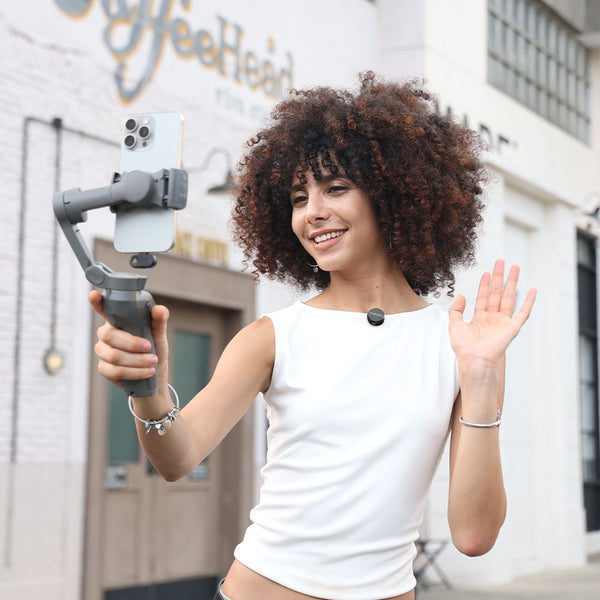Are you having trouble sleeping because of worries from the day or unresolved problems? Try meditation. Whether you're a beginner or already skilled in the practice, recording your own meditation or guided session using a wireless microphone and a smartphone can help others by sharing mindfulness. Meditation offers many benefits, such as reducing anxiety and stress, promoting better sleep, and much more. Let’s explore how to do it the right way.
In today’s fast-paced, noise-filled world, finding balance between inner peace and creative expression can be challenging. Meditation offers a path to calm the mind, while voiceover artistry provides a way to communicate that peace outwardly. Together, they form a powerful synergy — one that enhances focus, reduces stress, and allows your natural voice to flow effortlessly.

How Daily Meditation Transforms Focus, Stress, and Creativity
Meditation is more than just sitting quietly; it’s a daily practice that transforms how you engage with life. By dedicating even 10 to 20 minutes a day, you can train your mind to focus, regulate emotions, and manage stress more effectively. For creators, especially voice artists, this mental clarity translates into more confident, authentic, and expressive performances.
Why a Wireless Microphone Can Improve Your Voiceover Recordings
Just as meditation frees you from mental distractions, a wireless microphone liberates you from physical ones. Without the limitations of tangled cables or restricted movement, you can record in a more natural, relaxed posture — essential for calm, soothing narration in meditation or relaxation videos. High-quality microphones for video recording wireless setups, such as the Maono Wave T5 and Maono Wave T1 Mini, offer clean audio capture and freedom of movement that complements your meditative energy.
If you’re researching equipment, it helps to check the cordless microphone price or mic price wireless options within your budget. Many models today come as a rechargeable microphone, allowing long sessions without needing frequent battery changes.
The Science-Backed Benefits of Meditation for Mental Health
Numerous studies confirm that meditation reduces cortisol (the stress hormone), enhances mood, and even improves brain plasticity. Regular meditation strengthens the prefrontal cortex — the part of the brain responsible for focus, decision-making, and emotional regulation. It also decreases activity in the amygdala, which governs stress and fear responses.
For voiceover artists, this means better emotional control and more consistent performance during long recording sessions. A centered mind can bring out the richness and sincerity in your tone, helping listeners connect deeply with your message.
Morning vs Evening Meditation: Which Time Is Best for You?
There’s no single “best” time to meditate — it depends on your personal rhythm.
-
Morning meditation helps set a calm tone for the day, clearing mental clutter before work or creative projects.
-
Evening meditation, on the other hand, promotes relaxation and reflection after a busy day, releasing tension and preparing the mind for restful sleep.
For creators who record guided meditations or soothing voiceovers, combining both can be powerful. Morning sessions sharpen focus for recording, while evening ones help refine emotional tone and empathy.
Breathing Techniques That Enhance Your Meditation Practice
Breathing anchors the mind and helps control vocal tone — two key elements in both meditation and voiceover work. Try these simple techniques:
-
Box Breathing (4-4-4-4): Inhale for four counts, hold for four, exhale for four, and hold again. This helps calm anxiety and steady your breathing rhythm.
-
Diaphragmatic Breathing: Breathe deeply from the abdomen rather than the chest to expand lung capacity and produce a fuller voice.
-
Alternate Nostril Breathing (Nadi Shodhana): Balances the left and right hemispheres of the brain, promoting calm focus.
Practicing mindful breathing before recording sessions can enhance both mental clarity and vocal resonance.
Common Meditation Mistakes Beginners Should Avoid
Many beginners struggle with unrealistic expectations. Meditation isn’t about forcing the mind to be blank; it’s about observing thoughts without attachment. Other common pitfalls include:
-
Inconsistency: Skipping sessions breaks progress. Aim for short, daily practice instead of sporadic long ones.
-
Poor posture: Slouching or tension can cause discomfort and distraction. Sit upright yet relaxed.
-
Judging the experience: Some days are more focused than others — and that’s okay. Progress comes through patience.
By avoiding these mistakes, your meditation practice will support your creative flow and vocal control naturally.
Tips for Setting Up a Wireless Mic for Meditation or Relaxation Videos
If you’re creating guided meditations, your microphone setup should reflect the calm atmosphere you want to convey. Here’s how to set up your microphone for video recording wireless system effectively:
-
Choose a quiet space. Avoid rooms with echoes or background noise.
-
Use a pop filter or windscreen. It prevents harsh plosive sounds (like “p” and “b”).
-
Keep consistent mic placement. About 6–8 inches from your mouth works best for a soothing tone.
-
Record at moderate gain levels. Avoid distortion by keeping your volume under control.
-
Use soft furnishings. Carpets, curtains, and cushions help absorb unwanted reflections.
A well-optimized rechargeable mic setup ensures your audience hears every word clearly, with no distractions.
How to Record Crystal-Clear Voiceovers Without Background Noise
Clarity is everything in voiceovers, especially for meditation content where even slight noise can break the listener’s immersion. Here’s how to achieve studio-level quality at home:
-
Turn off fans, AC units, or buzzing electronics.
-
Use noise suppression tools in your recording software (like Adobe Audition or Audacity).
-
Record closer to the mic at a lower gain to reduce ambient noise pickup.
-
Invest in acoustic foam or blankets to soften echo-prone walls.
Wireless mics with high signal stability, such as the Maono Wave T5, maintain clear transmission without interference, helping your voice remain smooth and consistent.
Selecting the Equipment: The Best Wireless Mics for Calm, Soothing Voice Recordings
For meditation and relaxation videos, your microphone should capture warmth, clarity, and natural tone without hiss or harshness. Two excellent rechargeable microphone options include:
-
Maono Wave T5 Wireless Microphone

The Maono Wave T5 delivers studio-quality audio in a compact wireless design. Its noise reduction technology ensures that your recordings stay clean and professional, even in home environments. The long battery life, cordless microphone price, and stable transmission make it ideal for longer guided sessions or video shoots.
-
Maono Wave T1 Mini Wireless Microphone

Perfect for beginners or mobile creators, the Maono Wave T1 Mini offers plug-and-play simplicity. It’s lightweight, portable, and compatible with smartphones and cameras — ideal for recording meditation clips or short relaxation sessions anywhere. Its mic price wireless value makes it a smart, budget-friendly choice.
These both models deliver crystal-clear, soothing audio that complements the peaceful tone of meditation content.
Voice Control Tips: Achieving a Relaxed and Clear Tone with a Wireless Mic
To achieve a calm and natural tone, focus on breath control, posture, and pacing. Here are practical tips:
-
Warm up your voice with humming or gentle scales before recording.
-
Maintain consistent distance from your mic for even sound levels.
-
Speak slowly and with intention. Allow pauses for your audience to breathe and reflect.
-
Smile softly as you speak. It naturally brightens your tone.
-
Record in multiple takes. This allows you to choose the most relaxed version.
Remember, your voice is an extension of your inner state — the calmer your mind, the smoother your delivery.
FAQ Section
1. What are the proven mental health benefits of daily meditation?
It reduces stress, improves mood, enhances focus, and supports better emotional balance.
2. How long should beginners meditate each day for best results?
Start with 5–10 minutes daily and gradually increase as your comfort grows.
3. Can meditation really help improve concentration and productivity?
Yes, studies show consistent meditation enhances cognitive control and decision-making.
4. What’s the difference between mindfulness and meditation?
Mindfulness is about awareness in everyday life; meditation is the focused practice that cultivates it.
5. How can someone stay consistent with meditation in a busy lifestyle?
Set a fixed time each day, even just a few minutes, and treat it as self-care.
6. Are there specific meditation techniques to reduce anxiety or burnout?
Yes — guided meditation, deep breathing, and loving-kindness meditation are especially effective.
7. What type of environment helps create a more focused meditation session?
A quiet, clutter-free, and softly lit space encourages mental stillness.
8. How can music or guided meditation audio improve the experience?
It provides rhythm and structure, helping beginners maintain focus.
9. Is it better to meditate with eyes open or closed?
Closed eyes help reduce distractions, but open-eye meditation can enhance alertness.
10. What role does breathing play in deepening meditation practice?
It anchors attention and aligns body and mind into a relaxed state.
11. What are the advantages of using a wireless microphone for voiceovers?
Freedom of movement, fewer cables, and cleaner setups — ideal for creators recording in relaxed environments.
12. How can you position a wireless mic for the best sound quality?
Place it about 6–8 inches away from your mouth and slightly off-center to avoid plosives.
13. What are the best wireless microphones for meditation or relaxation content?
The Maono Wave T5 and Maono Wave T1 Mini are excellent for clarity and portability.
14. How can you avoid echo or interference during wireless mic recordings?
Record in a sound-treated space and ensure your transmitter-receiver line is unobstructed.
15. What’s the ideal recording environment for capturing clean voiceover audio?
A quiet, non-reflective room with minimal external noise.
16. How do you sync wireless mic audio with video footage smoothly?
Use editing software to align waveforms or claps at the start of the recording.
17. Can a wireless lavalier mic produce professional-quality voiceovers?
Absolutely — many modern wireless lavaliers, like the Wave T5, deliver studio-grade clarity.
18. What settings should you adjust for a soft and soothing vocal tone?
Lower the input gain, speak close to the mic, and use EQ to reduce harsh highs.
19. How does mic placement affect voice warmth and clarity?
Closer placement enhances warmth, while slightly off-axis reduces sibilance.
20. What are simple post-production tips to polish wireless mic recordings?
Apply light compression, noise reduction, and reverb for a smooth, natural finish.
21. Can I use a smartphone to record meditation sessions?
Yes, pair a wireless mic like the Maono Wave T1 Mini with your phone for professional-quality sound anywhere.
Conclusion
Meditation and voiceover artistry share a common essence — mindfulness, control, and emotional connection. When you calm your mind through meditation, your voice naturally gains clarity, depth, and authenticity. Pairing that with a reliable rechargeable microphone setup, like the Maono Wave T5 or T1 Mini, ensures your recordings sound as serene as your inner state.
Whether you’re recording guided meditations, relaxation podcasts, or voiceover scripts, remember this: your voice reflects your energy. Cultivate peace within, record with confidence, and let your calm mind create clear, captivating sound.
Now’s the perfect time to elevate your recording experience! Check out Maono’s Halloween deals to get your favorite rechargeable microphone or wireless mic at an unbeatable cordless microphone price. Don’t miss your chance to grab the best microphone for video recording wireless setup — enjoy premium sound quality at a surprisingly low mic price wireless and start creating with freedom and clarity today.
Related Article:
Why Wireless Microphones Are Essential for Teaching Meditation



